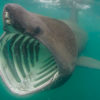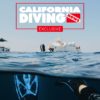As the boat pulled up close to Catalina Island I was as giddy as a schoolkid on Spring Break. This was going to be an electrifying dive. It had been several years since I had visited this site but what I remember was all good, but challenging. This dive site will definitely test your diving skills.
First, it is a drift dive. It must be done using a technique known as “live-boating.” Anchoring is not allowed in this preserve. Besides, it would be nearly impossible with the combination of a wall to 90 feet and then a very steep drop-off into deep waters. This, coupled with swift currents, means your boat skipper will need to drop you off at your entry point and then pick you up when you are finished. Be sure to equip with an inflatable safety sausage and an audible alarm like a Dive Alert™ or whistle, as these accessories will help the boat crew locate you more easily.
Our drop point was to be just up current from the main event of our dive, the deep cavern along the wall face that gives this site its name. Hitting the water we dropped almost immediately to 70 feet, the depth of the entrance to the hole in the wall. We missed it but at least we were up current.
My buddy and I moved in toward the wall to be greeted by a deep undercut that I mistook for the cavern. Poking my head in with my strobe modeling lights I saw several clumps of pink colonial cup coral above along with fish swimming upside down, orienting themselves to the ceiling of the overhang.
Realizing this was not the main cavern I moved out again along the wall and let the current push me gently along the face of the wall knowing that the dive boat skipper above was following our bubbles. Water clarity was excellent as is typical here so that even at 70 feet down I should have no problem finding the main hole.
Not too far down the wall was the cavern. The wall opened up some 40 feet across. Penetrating the cavern was easy enough and I ventured into the chamber 50 feet or so and even then I could see that it continued on for at least another 30 feet or more. My buddy ventured in as well and I popped off a few photos of him silhouetted against the blue that was framed by the rock entrance. It was mesmerizing.
Exiting the chamber we were once again under the influence of the current. Drift diving is fun in that you simply let the currents move you along.
Here and there the wall had protrusions and small shelves with lush healthy kelp clinging to the rocks. In some sections the kelp was quite thick. Add to this schools of blacksmith fish swirling about punctuated by bright orange Garibaldi and pink female sheephead and you have a truly enchanted kelp forest scene.
Holding onto the rocks under the kelp were fragile stars and blood stars. Gorgonians, bluebanded gobies and scorpionfish added pops of color. As much as you might be tempted to spend time doing macro photography, swift currents make it hard to stay in one spot. I suggest you concentrate on the magnificent wall, kelp and cavern wide-angle shots instead.
Toward the end of the dive the current whipped us around one of the small points. The current dropped off dramatically, but the water clarity also dropped.
Current diving can be challenging but oceanic currents provide the best water clarity — and plentiful fish life, too. If you don’t mind going with the flow, Blue Cavern has a lot to offer.







